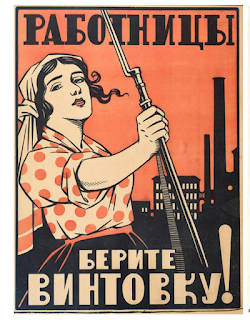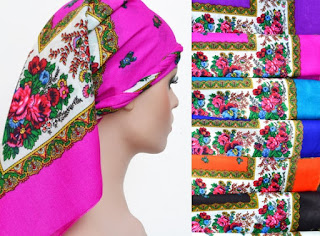Badass Babushkas: Scarves, Sunflower Seeds and Sacred Friendships from Ukraine
Babushka scarves are more than just fashion. In Russia, Ukraine, and the Americas they are a symbol of women's power, strength, and resiliency
- Babusya (Ukranian) and Babushka (Russian) both mean "grandmother"
- The defining piece of fashion for both babusyas and babushkas is a patterned scarf- worn over the hair and tied under the chin
- Grandmothers, women, and older ladies in both nations are to be respected- if not feared for their fierce love and strength
- The "babushka" scarf- as a symbol of friendship and solidarity, stretches far beyond the former Soviet Union to the Americas, and particularly to the Indigenous peoples of Canada and the U.S.
It's February 26th, 2022 and Russian forces approach Kyiv.
It's been a sad and terrifying two days for Europe, and of course no more so than for Ukrainians fighting an invading army and the negation of their right to exist as a nation. I am not Ukrainian and have not been lucky enough to visit. I am wary of seeming to take advantage of what's happening for the purposes of this blog.
If, however, I can help offer a human perspective on the strength, resiliency, and dignity of Ukrainian women, I think that's an appropriate move.
Because I do have a bit of experience with the figure of the babusya (and the babushka), and I have recently learned more about them, their fashion and beauty work, and the symbolism of the scarf associated with older women in Russia and Ukraine.
Babusyas and Babushkas
I was a Russian and Soviet Studies minor in college, and until recently, continued to teach about Russia and the former Soviet Union in a cultural studies course at my university. In that course, I used Yale Richmond's book about Russian culture, a book that devoted an entire chapter to the strength of Soviet Women.
(I am an old. For those not old enough to remember, Ukraine was a founding member of the USSR. As we have been hearing in the news, a part of the population of Ukraine is still both ethnically Russian and Russian-speaking. Ukrainian is a separate- though similar- language to Russian).
The general word for "grandmother" in Russian is babushka (ба́бушка) and in Ukrainian babusya (бабуся), as a pedantic languages professor, I should point out that "babusya" is sometimes used in Russian as well.
As an example, there is a 2003 Russian film called "Babusya" that tells the story of "An old Russian grandmother, a product of "old" Russia who took part in the Battle of Stalingrad, sacrificed everything for her children and even sold her house to get money for her grandchildren":
"Babushka" Scarves
a headscarf tied under the chin, typical of those traditionally worn by Russian women. As traditions grow and develop, these scarves are now sometimes tied at the nape of the neck, or wrapped and then tucked around the neck.
And are, apparently, "on-trend" in the West in the early-twenty-first century.
The traditional scarf, in medieval Rus,* was used as a fashion accessory that communicated a woman's social status, marital status, background, and place of origin. These scarves were hand-embroidered and often passed down from generation to generation.
Traditionally, only married women wore the scarf, as a woman's hair is often considered one of the most sexually attractive features- therefore a married woman would hide her hair to indicate both her status as "unavailable" and to not tempt men. Theorists like Nancy Etcoff would say that this is because the condition of a young woman's hair is a signal of her health and fertility.
If young, unmarried women cover their hair, the scarf can start to be associated with older women. What's more, the scarf, as a practical method of shielding the head from the sun and the cold can also communicate protection, security, and shelter.
Women's scarves in Ukraine and Russia today are usually printed, not embroidered, but the centuries-old tradition of wearing them remains mostly unchanged.
Ukrainian babusyas and Cree kokum
Kokum Scarves and Indomitable Women
"The Kokum Scarf that Indigenous Peoples wear was a gift from the Ukrainian peopleDuring the earlier parts of our developing relationship with the Eurpeans, the Ukrainian people would often trade with the Indigenous Peoples in the northern regions. They’d help each other out and created a lasting friendship with them. Many Ukrainian People still visit those areas today and maintain those friendships"
Linklater posted a photo of herself wearing a kokum scarf and calling on other indigenous women to wear their kokum as a signal of support for Ukraine.
"as just something they wore to keep their hair back while they chopped wood or skinned an animal. I have always seen it as a symbol of strength. My kokum always wore one. I don't think I ever saw her without one. . .When you wear it, you're remembering you aren't alone and you're remembering that you come from a long line of really strong women."
Work, strength, tradition, protection. The scarf- on Ukranian women or Cree women, isn't just fashion.
Worldwide Respect for Babusyas
"What the f*** are you doing here?""You're occupiers. You're fascists.""Take these sunflower seeds and put them in your pockets so at least sunflowers will grow when you all lie down (die) here"
This lady is now famous worldwide and I pray vehemently that she is well and survives.
She is not actually wearing a babushka scarf in this video but she is definitely channeling the power of the babusya and the kokum. Part of understanding Rus culture (Russian and Ukrainian) is to never underestimate the power of a babushka. Or a kokum, for that matter.
It is not in my religious tradition to offer tobacco- but my prayers are certainly lifted for the women (and men) of Ukraine.
In Russian, the word "peace" is the same as the word for "world" and "community": Mir (мир).
May the strength of grandmothers help lead our world to peace.






Comments
Post a Comment